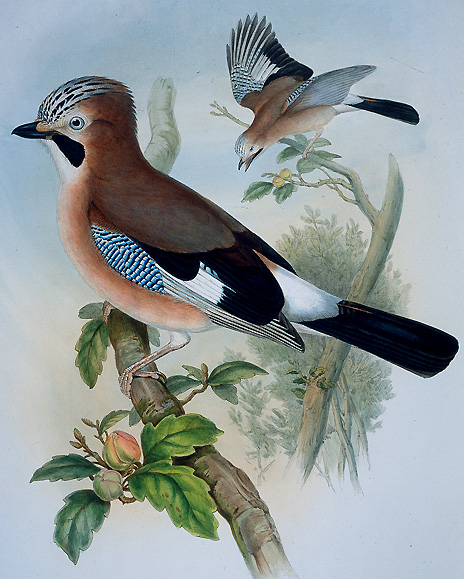 Eurasian Jay
Eurasian JayGarrulus glandarius glandarius (Linnaeus)
 Eurasian Jay
Eurasian JayThere are 34 sub-species of the Eurasian Jay, inhabiting a wide region that includes Europe, including the British Isles but excluding northern Scandinavia; northwest Africa, Asia Minor east to Manchuria, Japan, China, northern Laos and Vietnam.
Eurasian Jays are shy highly secretive birds that live in forests, and come out into open scrubland only to feed. However, even in dense woods, their presence can be detected through their harsh, raucous, cat-like cries.
The beautiful blue barred feathers from the wing of the Eurasian Jay were used in a feather art book containing scenes made entirely from bird feathers and skins. The book was made in 1618 by Dionisio Minaggio, an Italian gardener, and these skins are believed to be the oldest in existence. In the nineteenth century, some jays were kept as pets; Gould (1850-1883) writes: "In captivity, this bird becomes a favourite, from its pert and familiar manners, and its aptness in learning words and even sentences."
Shakespeare several times alluded to the Eurasian Jay (Harting 1965). For example, in Cymbeline when referring to a gaudily dressed person in Act 3, Scene 4 ('Some jay of Italy hath betray'd him...) and then again in Taming of the Shrew, Act 4, Scene 3, "What, is the jay more precious than the lark, Because his feathers are more beautiful?"
Feathers from the Eurasian Jay have been widely used in trout flies, salmon flies, seatrout flies and lake flies. For example, the primaries are used for wings for the large British wet flies such as Lee's Favourite, Saltoun and Hawthorn (Veniard 1952). "The ruddy, soft hackle on the shoulder and under the wing are said to make an excellent spider pattern of the Red Spinner" (V.C. 1950) while the tips of the bright blue and black barred lesser wing coverts from the Eurasian Jay have been used as wings for wet flies such as the Blue Jay, Jay Blue, Jay Yellow, and Jay Silver (Bergman 1938). Tolfrey (1848) calls for Jay as the wing of Lake Fly #2.
These same blue and black lesser wing covert feathers were also commonly used in salmon flies. The finest examples of their use may be seen in the flies of Major John Popkin Traherne (1826-1901) who used these entire feathers for body veilings in the Jay P.T. and Nelly Bly, for the throat in the Lapwing, and for the cheek in the Chatterer.
Most notably, however, the black and blue feathers have been used as hackle in trout and salmon flies such as Connemara Black and Invicta, and for numerous salmon flies, such as Sir Percy, Thunder and Lightening, Golden Drop, Excelsior, and Popham.
If you want to know more about the Eurasian jay and other birds related to our fly tying heritage, we suggest you order Rare and Unusual Fly Tying Materials: A Natural History.